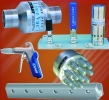Compressed air savings a priority
January 2006
Pneumatics & Hydraulics

We have all heard the bad news regarding the expected rise in energy cost. Now is the time to look for ways to conserve energy. Almost every industrial facility has at least one compressor that is used for hundreds of different tools, equipment and operations. Improper use can translate into unnecessary energy costs and high noise levels. Now is the time to start boosting efficiency.
The use of compressed air for blow off in most facilities is a problem due to the energy costs, noise level and potential danger to personnel exposed to the high pressure. Open air pipes, copper tubes and drilled pipes are a few of the common abusers. They consume huge amounts of energy and often produce noise levels over 100 dBA.
The best way to cut energy costs is through proper maintenance and use of the compressed air system. Leaks and dirty filters require maintenance on a regular basis. Energy savings can also be realised when replacing outdated compressor motors that often pay for themselves in a short period of time.
The most important factor to dramatically boost efficiency is proper use. Using engineered products like Exair's new Super Air Nozzle can cut operating costs since it uses only a fraction of the compressed air typical blow offs. In addition, all Exair jets and nozzles can be cycled on and off with instant response so the compressed air is only used when needed.
For example, a 1/8-inch open pipe blow off system at 550 kPa uses 2 m3 per minute. Replacing the open pipe with an Exair Adjustable Air Nozzle model 1009SS, will result in a reduction down to 0,37 m3 per minute at 550 kPa - a saving of 1,63 m3 per minute.
The air saved in this example is sufficient to run two Exair Panel Coolers (model 4030) to stop electronic downtime due to heat. These keep the electronics cool and simultaneously positively pressurise the panels, keeping them clean and dry, thus reducing maintenance and housekeeping costs. Further savings may be had by thermostatically controlling the panel cooler, so that it will only run when heat levels become critical, conserving air accordingly.
Often blowers are chosen over compressed air driven units due to their slightly better electrical consumption compared to a compressor. In reality, a blower is an expensive capital expenditure that requires frequent downtime and costly maintenance of filters, belts and bearings. Blowers take up a lot of space and often produce sound levels that exceed OSHA noise level exposure requirements. Air volume and velocity are often difficult to control since mechanical adjustments are required. Notwithstanding the fact that often water is not completely removed from the product and can backlash in the form of 'rust under bottle tops'.
All Exair equipment meets or exceeds OSHA requirements on noise and dead end pressure levels. Making it one of the safest, cost effective and efficient compressed air product ranges available.
Further reading:
Robust sensors for pneumatic applications
ifm - South Africa
Pneumatics & Hydraulics
The pressure sensors from ifm have a G1/8 process connection, combined with a welded thin-film measuring cell. While offering an unbeatable price/performance ratio, this technology provides for high measuring accuracy in a very compact and robust housing.
Read more...
Seven years of uninterrupted service
Pneumatics & Hydraulics
A set of hydraulically operated Corflex pinch valves, installed in 2018 at a major North African gold mine, has delivered in one of the continent’s most demanding slurry-handling applications.
Read more...
Controlling pneumatics via IO-Link
ifm - South Africa
Pneumatics & Hydraulics
Pneumatic airboxes control cylinders or actuators using compressed air, and are found in a wide range of industrial applications.
Read more...
Counterweight balancing in industrial robots
Pneumatics & Hydraulics
Hydraulics specialist, WEBER-HYDRAULIK is equipping KUKA robots with a hydraulic cylinder with an integrated pressure accumulator, which absorbs and balances the forces generated on the arm.
Read more...
How manufacturers achieve zero-leakage demands in hydraulic cylinders
Pneumatics & Hydraulics
Imagine a world where your hydraulic cylinders never leaked. The answer lies in a holistic approach that focuses on the fundamental components and their interactions, particularly the cylinder rod and its surrounding environment.
Read more...
The role of hydraulic systems in heavy machinery
Pneumatics & Hydraulics
In this article, we explore how hydraulic systems function, their role in powering heavy equipment, and why they are the preferred choice for industries requiring immense power and precision.
Read more...
Reliable, flexible and cost-effective rental compressed air
Pneumatics & Hydraulics
More businesses are turning to Integrated Air Solutions for rented on-demand compressed air, without the burden of capital expenditure.
Read more...
Axiom expands its hydraulic solutions with Powerstart piston accumulators
Axiom Hydraulics
Pneumatics & Hydraulics
Axiom is proud to announce a unique partnership with Powerworks, introducing a new generation of piston accumulators into the South African market, the Powerstart piston accumulators.
Read more...
Dynamic compressor control system with energy savings
Pneumatics & Hydraulics
CompAir has launched Ecoplant, a dynamic, compressed air management solution that adjusts compressor parameters in real time, offering up to 30 per cent reductions in energy costs and CO
2 emissions.
Read more...
Festo commits to a greener industrial future by driving sustainability and energy efficiency
Festo South Africa
Pneumatics & Hydraulics
As the world is facing significant ecological, social and economic challenges, Festo is taking proactive responsibility. Their goal is to contribute to a more sustainable future through the development of innovative technologies and responsible actions.
Read more...


